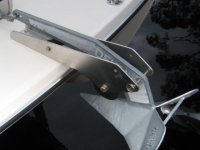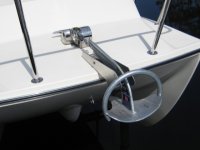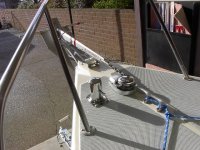As promised I did tests on multiple anchors on Feb 16. on upper Perdido Bay. The bottom was about 2" of soft non cohesive mud, then 3" of cohesive mud, and finally several feet of combination co-hesive mud, sand and seashells. The air temp was 75 degrees, water temp 64 degrees, clear conditions with a 15 to 18 knots from the East, and minimal waves, since I was about 300 yards from the Eastern shore.
Each pass was in a slightly different place, so that no "disturbed bottom" was used.
The boat is an 18 foot 2003 Century center console, 8' beam, 15 degree dead rise and weight 1800 lbs. The engine is a 2003 115 HP fuel injected Yahama 115 lbs. The prop is 14" diameter x 15" pitch. The WOT RPM is 5500 and speed of 37 knots.
The anchor rode was 9/16" Dacron tow line (designed for drogues, low stretch but suppple). I did not want spring in the test line. No chain was depoyed (mostly to make it easier to get the anchor up) Chain might have helped set the anchor, but would have made no difference in the ultimate holding power.
Method. The boat was brought to a stand still in reverse. The anchor was lowered to the bottom in about 4 feet of water. A PVC pipe was put in the water right were the anchor was dropped. When the anchor was retrieved, the distance from this pipe (amount drug before fully setting) was measured, by the distance of the dug in anchor to the pipe.
After the anchor was on the bottom the anchor rode was paid out until a scope of 7:1 was reached. There was a slight tension on the rode (about 5 lbs) to feel if the anchor was dragging. If it was dragging, the rode was allowed to go slack and then light pressure again applied. When the rode was at 7:1, (including the distance of the cleate off the water), it was cleated off. A second piece of PVC pipe was put in the water and felt to see if the anchor was dragging. If it was dragging, the anchor was attempted to be re-set, or pulled on in slighly jerks to attempt to be set. The wind alone against the boat hull was putting 35 lbs of force on the anchor rode. Once set, the engine was put in gear at 600 RPM idle. The force measured on a spring scale was 100 lbs. If the anchor held at this load, then the throttle was gradually applied to 3600 RPM--this was the max RPM reached with the boat stationary, and the engine all of the way down. Normally the 3600 RPM would put the boat quickly on a plane, and sustain a cruising speed of about 22 knots. I estimated the bollard pull load at over 1000 lbs. Far more than the average boat would achive in winds less than 60 knots. The boat would crab sideways--to 90 degrees. I would take the boat back and re try again at 3600 RPM x 2 more times.
Weight on spring scales, which seem accurate. Fluke area measured, and is some what approximated because of the rounding of fluke edges.
Anchors:
Danforth standard 8 lbs Wt 8 lbs, 46 sq inches of fluke area. This anchor never properly set under these conditions. Just skipped across the bottom
Guardian G7 (cheap fortress)--4 lbs, fluke area 50 sq inches of fluke area,
It dug in and then pulled out at 3:1 scope, but seemed to be holding at 7:1 scope. It slowly drug about 20 feet and pulled out at about 1000 PRM--I estimated about 100 lbs. It would not reset as the boat was drifting.
Fortress FX 16 Wt 10 lbs, fluke area 266 sq inches, in standard position.
Set rapidly did not drag more than 3 feet at 3 runs up to max RPM
Northill Folding Sea Plane SS anchor: Weight 12 lbs, fluke each fluke 154 sq inches. Anchor set promptly did not drag initially. Held up to 1800 RPM and estimated 800 lbs.
Manson Supreme: 25 lb, Fluke area 192 sq inches, set promptly did not seem to drag, held to max RPM with minimal drag--not more than 2 feet.
Delta Fast set 22lb Fluke area 220 sq inches, drug a foot or so, set well, stayed set at full PRM, with about 5 foot total drag.
Danforth 35 lbs(WWII, Cast or forged and riveted crown)--simlar to the High Test or Performance anchor Fluke area 192 sq inches. This anchor set rapidly and did not appear to drag. Held at max RPM. This same anchor held my Cal 46 in 87 knots of wind.
Summary: The Danforth 8 lb did't have sharp enough edges, or was not able to penetrate the surface and did not set. This is a fairly commonly used anchor of the CD 22, and in this test failed.
The Guardian, is too light to pentrate to any depth. Notice that the much larger fluke area, and only 6# more weight FX 16 set well and did not drag.
The Danforth 35lbs is too heavy to be practical--and probably will not fit well on the standard bow puplits, plus no advantage over the other anchors.
The Delta and Manson Supreme were equal in these tests. The Danforth fits the bow roller/pulpit very well, and I put a fast pin thru the crown hole to secure the anchor on the roller. The Manson Supreme does not have a hole which can be used to secure it. It does fit on the Tom Cat Roller. Although they seemed equal, I suspect that in some conditions the Manson would do better. There was more mud on its fluke than any of the other anchors.
Although the Northill is a nice and light anchor, it did fail, and is probably not worth carrying--except on some grass types. I'll probably put mine in the "anchor" musuem-in my garage.
I'll post photos of the anchors tomarrow.
Each pass was in a slightly different place, so that no "disturbed bottom" was used.
The boat is an 18 foot 2003 Century center console, 8' beam, 15 degree dead rise and weight 1800 lbs. The engine is a 2003 115 HP fuel injected Yahama 115 lbs. The prop is 14" diameter x 15" pitch. The WOT RPM is 5500 and speed of 37 knots.
The anchor rode was 9/16" Dacron tow line (designed for drogues, low stretch but suppple). I did not want spring in the test line. No chain was depoyed (mostly to make it easier to get the anchor up) Chain might have helped set the anchor, but would have made no difference in the ultimate holding power.
Method. The boat was brought to a stand still in reverse. The anchor was lowered to the bottom in about 4 feet of water. A PVC pipe was put in the water right were the anchor was dropped. When the anchor was retrieved, the distance from this pipe (amount drug before fully setting) was measured, by the distance of the dug in anchor to the pipe.
After the anchor was on the bottom the anchor rode was paid out until a scope of 7:1 was reached. There was a slight tension on the rode (about 5 lbs) to feel if the anchor was dragging. If it was dragging, the rode was allowed to go slack and then light pressure again applied. When the rode was at 7:1, (including the distance of the cleate off the water), it was cleated off. A second piece of PVC pipe was put in the water and felt to see if the anchor was dragging. If it was dragging, the anchor was attempted to be re-set, or pulled on in slighly jerks to attempt to be set. The wind alone against the boat hull was putting 35 lbs of force on the anchor rode. Once set, the engine was put in gear at 600 RPM idle. The force measured on a spring scale was 100 lbs. If the anchor held at this load, then the throttle was gradually applied to 3600 RPM--this was the max RPM reached with the boat stationary, and the engine all of the way down. Normally the 3600 RPM would put the boat quickly on a plane, and sustain a cruising speed of about 22 knots. I estimated the bollard pull load at over 1000 lbs. Far more than the average boat would achive in winds less than 60 knots. The boat would crab sideways--to 90 degrees. I would take the boat back and re try again at 3600 RPM x 2 more times.
Weight on spring scales, which seem accurate. Fluke area measured, and is some what approximated because of the rounding of fluke edges.
Anchors:
Danforth standard 8 lbs Wt 8 lbs, 46 sq inches of fluke area. This anchor never properly set under these conditions. Just skipped across the bottom
Guardian G7 (cheap fortress)--4 lbs, fluke area 50 sq inches of fluke area,
It dug in and then pulled out at 3:1 scope, but seemed to be holding at 7:1 scope. It slowly drug about 20 feet and pulled out at about 1000 PRM--I estimated about 100 lbs. It would not reset as the boat was drifting.
Fortress FX 16 Wt 10 lbs, fluke area 266 sq inches, in standard position.
Set rapidly did not drag more than 3 feet at 3 runs up to max RPM
Northill Folding Sea Plane SS anchor: Weight 12 lbs, fluke each fluke 154 sq inches. Anchor set promptly did not drag initially. Held up to 1800 RPM and estimated 800 lbs.
Manson Supreme: 25 lb, Fluke area 192 sq inches, set promptly did not seem to drag, held to max RPM with minimal drag--not more than 2 feet.
Delta Fast set 22lb Fluke area 220 sq inches, drug a foot or so, set well, stayed set at full PRM, with about 5 foot total drag.
Danforth 35 lbs(WWII, Cast or forged and riveted crown)--simlar to the High Test or Performance anchor Fluke area 192 sq inches. This anchor set rapidly and did not appear to drag. Held at max RPM. This same anchor held my Cal 46 in 87 knots of wind.
Summary: The Danforth 8 lb did't have sharp enough edges, or was not able to penetrate the surface and did not set. This is a fairly commonly used anchor of the CD 22, and in this test failed.
The Guardian, is too light to pentrate to any depth. Notice that the much larger fluke area, and only 6# more weight FX 16 set well and did not drag.
The Danforth 35lbs is too heavy to be practical--and probably will not fit well on the standard bow puplits, plus no advantage over the other anchors.
The Delta and Manson Supreme were equal in these tests. The Danforth fits the bow roller/pulpit very well, and I put a fast pin thru the crown hole to secure the anchor on the roller. The Manson Supreme does not have a hole which can be used to secure it. It does fit on the Tom Cat Roller. Although they seemed equal, I suspect that in some conditions the Manson would do better. There was more mud on its fluke than any of the other anchors.
Although the Northill is a nice and light anchor, it did fail, and is probably not worth carrying--except on some grass types. I'll probably put mine in the "anchor" musuem-in my garage.
I'll post photos of the anchors tomarrow.




